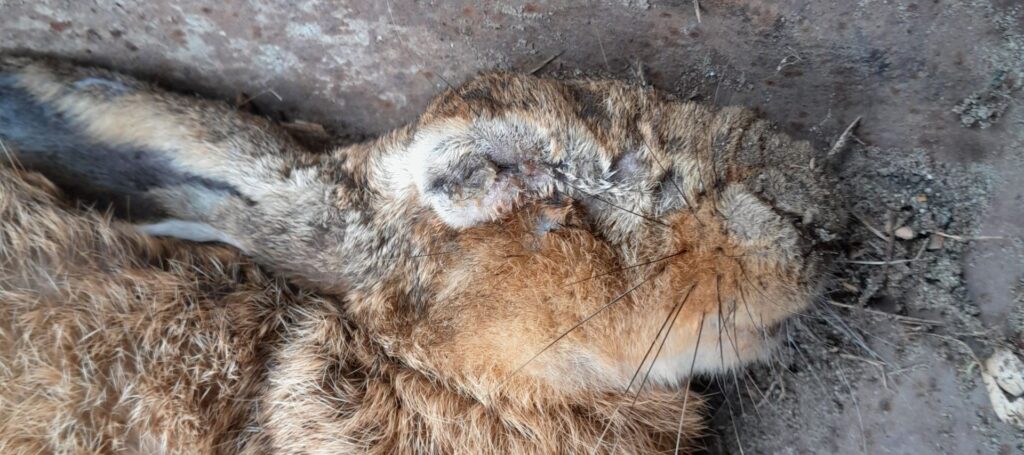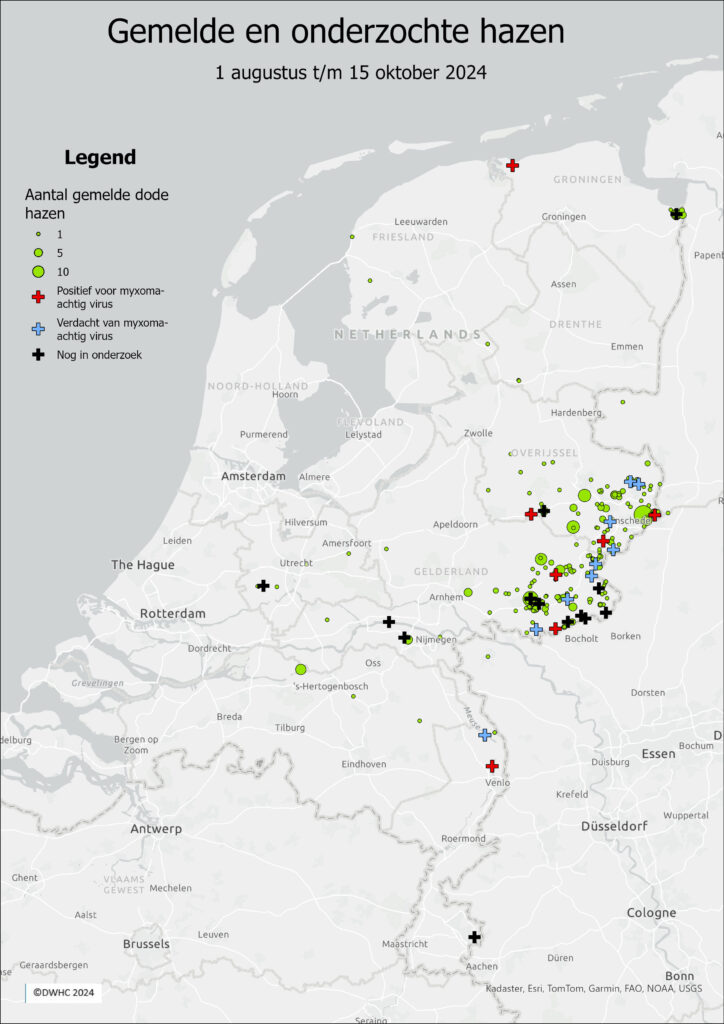

Since August 1st, the number of reports of sick and dead hares (Lepus europaeus) has increased. These reports are mainly from Gelderland and Overijssel.

Many of these hares were found with swollen eyes or behaviour that resembled the behaviour of “rabbits with myxomatosis”: they appear blind and fall over. Dead hares were also often found “just somewhere in the grass” instead of in their lair.

Many of the collected hares had thickening and inflammation of the skin around the eyes and nose as well as around their anus. In addition, pneumonia was found in many hares.
Some hares were tested for infection with treponema (”hare syphilis”) and myxomatosis by means of PCR. All tested hares were negative for “hare syphilis” but positive for myxomatosis. In collaboration with colleagues in Germany, research is ongoing to determine whether this myxoma-like virus is the same as the one found in rabbits, or whether this is a different variant. The disease has also been detected across the border in Germany.
In addition, there are hares being examined at this time, and more animals are being collected for research as well. We are monitoring where hares with these myxomatosis-like abnormalities occur, but also what other diseases could possibly play a role in the increased mortality of hares. In addition to reports of sick and dead hares, we would also like to receive reports of sick and dead wild rabbits for our research.
Some hares are not suitable for research as they have been laying in the field for a long time. Due to the rapid spread of this new disease among hares, it is important that the dead hares are disposed of. It is important to double-wrap the animals in plastic and to dispose of them in the residual waste (grey bin). Residual waste will be destructed which prevents a possible source of contamination for the hare population.
The causative agent of myxomatosis, the myxoma virus (Leporipoxvirus), is considered an important cause of mortality in wild rabbits (Oryctolagus cuniculi) in Europe (Bertagnoli et al., 2015). The natural host of the virus is the Brazilian rabbit (Sylvilagus brasiliensis). The myxoma virus was introduced into France from South America in 1952 (Kerr, 2012). Myxomatosis has also been detected in wild European rabbits in the Netherlands (DWHC annual report 2020, pg. 15; https://dwhc.nl/publicaties/). The myxoma virus is mainly transmitted by blood-sucking insects such as fleas and mosquitoes.
Until recently, myxomatosis was rare to be found in hares (Barlow et al., 2014; DWHC annual report 2016, pg. 9; https://dwhc.nl/publicaties/). However, a variant of the myxoma virus (ha-MYXV) has caused high mortality in the Iberian hare (Lepus granatensis) in Spain since 2018 (Garcia-Bocanegra et al., 2019; Dalton et al., 2019). This variant was later also found in hares and rabbits in Portugal (Abade dos Santos et al., 2020; Cardoso et al., 2024). Vaccination with commercial vaccines protected the wild rabbits, however they were only partially protective (only at high doses) for Iberian hares (Abade dos Santos et al., 2022). The disease has an impact on the size of Iberian hare populations (Cardoso et al., 2024).
Abade dos Santos, F. A., Carvalho, C. L., Pinto, A., Rai, R., Monteiro, M., Carvalho, P., Mendonça, P., Peleteiro, M.C., Parra, F., & Duarte, M. D. (2020). Detection of recombinant hare myxoma virus in wild rabbits (Oryctolagus cuniculus algirus). Viruses, 12(10), 1127.
Abade dos Santos, F. A., Carvalho, C. L., Valente, P. C., Armés, H., Reemers, S. S., Peleteiro, M. C., Calonge Sanz, I., Dalton, K.P., Parra, F., & Duarte, M. D. (2022). Evaluation of commercial myxomatosis vaccines against recombinant myxoma virus (ha-MYXV) in Iberian hare and wild rabbit. Vaccines, 10(3), 356.
Barlow, A., Lawrence, K., Everest, D., Dastjerdi, A., Finnegan, C., & Steinbach, F. (2014). Confirmation of myxomatosis in a European brown hare in Great Britain. The Veterinary Record, 175(3), 75-76.
Bertagnoli, S., & Marchandeau, S. (2015). La myxomatose. Revue Scientifique et Technique International Office of Epizootics, 34(2), 539-547.
García‐Bocanegra, I., Camacho‐Sillero, L., Risalde, M. A., Dalton, K. P., Caballero‐Gómez, J., Agüero, M., Zorrilla, I., & Gómez‐Guillamón, F. (2019). First outbreak of myxomatosis in Iberian hares (Lepus granatensis). Transboundary and Emerging Diseases, 66(6), 2204-2208.
Cardoso, B., García-Bocanegra, I., Queirós, J., Fernández-López, J., Alves, P. C., & Acevedo, P. (2024). Effect of Myxoma Virus Species Jump on Iberian Hare Populations. Emerging Infectious Diseases, 30(6), 1293.
Dalton, K. P., Martín, J. M., Nicieza, I., Podadera, A., de Llano, D., Casais, R., Gimenez, S., Badiola, I., Agüero, M., Duran, M., Buitrago, D., Romero, L.J., García, E., & Parra, F. (2019). Myxoma virus jumps species to the Iberian hare. Transboundary and Emerging Diseases, 66(6), 2218-2226.
Kerr, P. J. (2012). Myxomatosis in Australia and Europe: a model for emerging infectious diseases. Antiviral research, 93(3), 387-415.